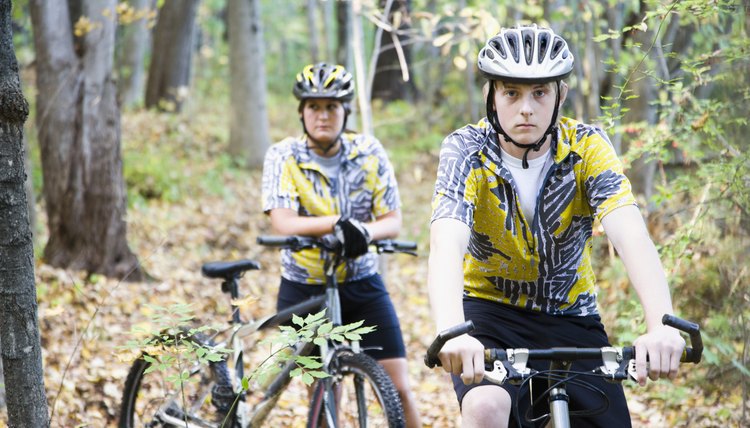How Do Bar Ends Work on a Bicycle?

Bar ends are an accessory to handlebars on mountain bikes. They're the stubby additions to both ends that make your handlebars appear like the horns of a bull. They have purpose for the majority of mountain bikers, while others dislike them. If you're serious about getting the most from your mountain bike, bar ends can make a difference in performance and comfort. Put some on your bike and you'll likely agree that life behind bars is pretty cool.
Placing Weight
Bar ends work as an aid for climbing. Unlike the torso-forward position on road bikes, mountain bike geometry channels weight to the back wheel. The position aids climbing, but at the same time makes the front wheel lighter and can cause the front end of the bike to lift. Bar ends allow you to move your weight forward on the bike and lowers the center of gravity at the same time, keeping your front tire planted firmly on the ground where it belongs.
Mash With Leverage
Leverage is another application of bar ends for climbing. With both hands on the bar ends, you can apply more pressure to the pedals by pulling up on the bar ends while pushing down on the pedals. Also known as mashing the pedals, the advantage can make all the difference on steep hills when your speed drops, your heart rate rises and leverage is about all you have left to keep the bike moving.
Handy Positions
Secondary only to the advantages in climbing, hand position is another benefit gained from bar ends. One of the major complaints of cyclists is numb hands, wrists or fingers caused from too much pressure on the hands or an extended amount of time with hands in a single position. Bar ends allow a combination of hand positions to alleviate pressure. They allow you to tilt your hands diagonally and, depending on how the bars are shaped, allow you to turn your hands almost 90 degrees to prevent numb extremities. The torso-forward position when your hands are on the bars also helps to stretch out stiff spines.
The Fast Getaway
Bar ends allow you to get off the line faster. By placing your hands on the bar ends, you can get out of the saddle for a fast getaway. This places your body in an aerodynamic position, and by pulling on the bar ends while standing and pedaling, it creates faster, more efficient sprinting on flat ground. The upright position with your hands on regular handlebars makes for a semi-relaxed posture. It's slower and more applicable to cruising than sprinting.
Give Me A Lift
One overlooked benefit is realized when you need to change a tire or work on your bike. Thanks to the angled, upright position, bar ends lift the handlebars off the ground, providing a relief or space underneath to protect computers or other electronic devices on your handlebars. Bar ends add stability to the bike while you change the tire, helping prevent the bike from tipping while you work. Bar ends keep cables, hand grips and the handlebars themselves from getting beat up or scratched on rough ground or pavement. Keeping your handlebars off the ground is particularly important if you have carbon handlebars.
Look Mom, No Brakes
Bar ends can't help to stop a bike in motion. Bar ends don't typically have brake handles. When your hands are on the bar ends the bike is free-wheeling. For this reason alone, bar ends should be restricted to climbing or cruising. Always keep two hands on the handlebars when riding downhill and remember the rule -- two up and two down -- meaning at least two fingers on the handlebars and two fingers on the brakes. Skip the bars when riding downhill.
References
Writer Bio
Specializing in hardwood furniture, trim carpentry, cabinets, home improvement and architectural millwork, Wade Shaddy has worked in homebuilding since 1972. Shaddy has also worked as a newspaper reporter and writer, and as a contributing writer for Bicycling Magazine. Shaddy began publishing in various magazines in 1992, and published a novel, “Dark Canyon,” in 2008.
